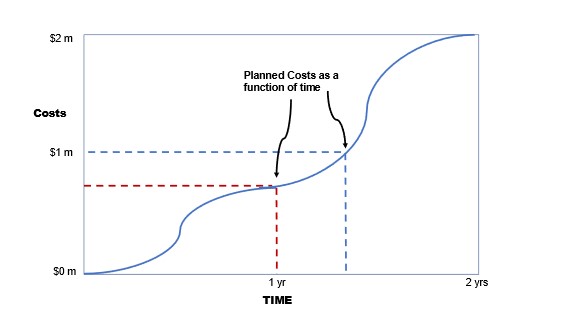SECOND EDITION
By Dr. Kenneth Smith, PMP
Manila, The Philippines
PERT-Cost is a relatively new management technique in the complex field of Research and Development management – an extension of the more familiar PERT-Time, Critical Path methodology which has gained wide acceptance in government and industry. Although PERT-Cost is required on many large-scale R&D projects within the Department of Defense, and can be extremely useful in managing others, many individuals hold PERT-Cost sub judice, hesitating and uncertain whether it is a major breakthrough in management or just another system, trading on a familiar name.
One of the most controversial aspects of PERT-Cost is an item called “Value of Work Completed,” or more usually, just “Value.” Significantly, “Value” lies at the heart of PERT-Cost and a thorough understanding of it is essential to evaluating the entire system.
The term “Value” itself gives rise to much of the confusion due to a natural tendency to ascribe a familiar meaning to a familiar word. “Value,” as used in PERT-Cost, is not too far removed from Webster’s definition of “the worth of a thing in money . . . at a certain time,” or even an estimated or appraised worth . . . in a scale of values.” It is indeed an attempt to measure a project in terms of money at a particular point in time, and also to provide an estimated worth in a scale of values, but here the similarity ends. “Value” is meant to provide the manager with a measure of progress in monetary terms so that he may have a basis for taking corrective action, if necessary. It is not intended to be a measure to identify “bargains” per se in the sense of good value.
“Value” Defined
If “Value” is not meant to indicate bargains, what precisely is it meant to do? Perhaps under the circumstances it would be wisest to redefine it. Actually, “Value” is nothing more than an attempt to evaluate where you are in your project, expressed in dollars, in terms of your planned estimate. By comparing where you are with where you should be, a basis is provided for taking necessary corrective action.
“Value” promises much – but what did it replace? After all, managers have been faced with these kinds of questions for years.
In the early management days – B.P.C. (before PERT-Cost) – managers used Gantt Charts, Bar Charts, Milestone Charts in various forms, in planning their projects. Progress on these charts was usually indicated by a line and expressed in terms of “Percentage of Completion” with time as their basis. When managers became more cost conscious, they realized that they could also evaluate a project by the amount expended, compared to the total amount estimated for the whole project. Of course, the two did not always coincide – there is not necessarily a direct relationship between time and money. Later, as managers became even more sophisticated in project management, they predetermined a rate of spending, and then measured actual expenditures against original estimates during the time period. This resulted in a so-called “S” curve.

FIGURE 1
With this type of display, the manager could keep track of his project, knowing precisely where he should be at any time, and ready to take corrective action, should it become necessary. What a happy ending!
Unfortunately, this did not always reflect the reality of the situation. Sometimes the money would be expended in a timely manner, or even “ahead of schedule,” but ultimately when the day of reckoning came – either the time ran out, or the money was all gone – but the project was not completed! Schedule slippages and cost overruns were incurred. Actually, management would usually be aware of the impending trouble, usually about the 87% completion point of either time or money, but by then, there would be little time remaining to plan ahead!
More…
To read entire article, click here
Editor’s note: Second Editions are previously published papers that have continued relevance in today’s project management world, or which were originally published in conference proceedings or in a language other than English. Original publication acknowledged; authors retain copyright. This paper was originally published in the Navy Management Review in 1965. It is republished here with the author’s permission to provide another historical look at the early days of project management and earned value management (EVM).
How to cite this paper: Smith, K. F. (1965). What is the Value of Value? republished in the PM World Journal, Vol. XI, Issue VI, November 2022. Originally published in Navy Management Review, NAVSO, P910, Vol X, No. 8, Office of Management Information, U.S. Navy, August, page 4. Available online at https://pmworldlibrary.net/wp-content/uploads/2022/11/pmwj123-Nov2022-Smith-what-is-the-value-of-value.pdf
About the Author

Dr. Kenneth Smith
Honolulu, Hawaii
& Manila, The Philippines
![]()
![]()
Initially a US Civil Service Management Intern, then a management analyst & systems specialist with the US Defense Department, Ken subsequently had a career as a senior foreign service officer — management & evaluation specialist, project manager, and in-house facilitator/trainer — with the US Agency for International Development (USAID). Ken assisted host country governments in many countries to plan, monitor and evaluate projects in various technical sectors; working ‘hands-on’ with their officers as well as other USAID personnel, contractors and NGOs. Intermittently, he was also a team leader &/or team member to conduct project, program & and country-level portfolio analyses and evaluations.
Concurrently, Ken had an active dual career as Air Force ready-reservist in Asia (Japan, Korea, Vietnam, Thailand, Indonesia, Philippines) as well as the Washington D.C. area; was Chairman of a Congressional Services Academy Advisory Board (SAAB); and had additional duties as an Air Force Academy Liaison Officer. He retired as a ‘bird’ colonel.
After retirement from USAID, Ken was a project management consultant for ADB, the World Bank, UNDP and USAID.
He earned his DPA (Doctor of Public Administration) from the George Mason University (GMU) in Virginia, his MS from Massachusetts Institute of Technology (MIT Systems Analysis Fellow, Center for Advanced Engineering Study), and BA & MA degrees in Government & International Relations from the University of Connecticut (UCONN). A long-time member of the Project Management Institute (PMI) and IPMA-USA, Ken is a Certified Project Management Professional (PMP®) and a member of the PMI®-Honolulu and Philippines Chapters.
Ken’s book — Project Management PRAXIS (available from Amazon) — includes many innovative project management tools & techniques; and describes a “Toolkit” of related templates available directly from him at kenfsmith@aol.com on proof of purchase of PRAXIS.
To view other works by Ken Smith, visit his author showcase in the PM World Library at https://pmworldlibrary.net/authors/dr-kenneth-smith/









